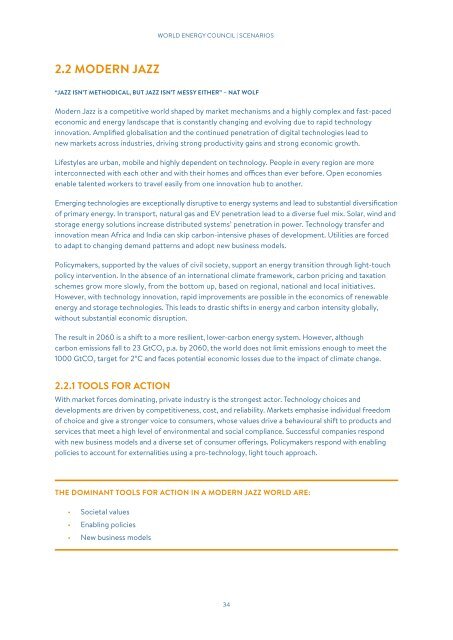World Energy Scenarios
b9Sz9NC
b9Sz9NC
You also want an ePaper? Increase the reach of your titles
YUMPU automatically turns print PDFs into web optimized ePapers that Google loves.
WORLD ENERGY COUNCIL | SCENARIOS<br />
2.2 MODERN JAZZ<br />
“JAZZ ISN’T METHODICAL, BUT JAZZ ISN’T MESSY EITHER” – NAT WOLF<br />
Modern Jazz is a competitive world shaped by market mechanisms and a highly complex and fast-paced<br />
economic and energy landscape that is constantly changing and evolving due to rapid technology<br />
innovation. Amplified globalisation and the continued penetration of digital technologies lead to<br />
new markets across industries, driving strong productivity gains and strong economic growth.<br />
Lifestyles are urban, mobile and highly dependent on technology. People in every region are more<br />
interconnected with each other and with their homes and offices than ever before. Open economies<br />
enable talented workers to travel easily from one innovation hub to another.<br />
Emerging technologies are exceptionally disruptive to energy systems and lead to substantial diversification<br />
of primary energy. In transport, natural gas and EV penetration lead to a diverse fuel mix. Solar, wind and<br />
storage energy solutions increase distributed systems’ penetration in power. Technology transfer and<br />
innovation mean Africa and India can skip carbon-intensive phases of development. Utilities are forced<br />
to adapt to changing demand patterns and adopt new business models.<br />
Policymakers, supported by the values of civil society, support an energy transition through light-touch<br />
policy intervention. In the absence of an international climate framework, carbon pricing and taxation<br />
schemes grow more slowly, from the bottom up, based on regional, national and local initiatives.<br />
However, with technology innovation, rapid improvements are possible in the economics of renewable<br />
energy and storage technologies. This leads to drastic shifts in energy and carbon intensity globally,<br />
without substantial economic disruption.<br />
The result in 2060 is a shift to a more resilient, lower-carbon energy system. However, although<br />
carbon emissions fall to 23 GtCO₂ p.a. by 2060, the world does not limit emissions enough to meet the<br />
1000 GtCO₂ target for 2°C and faces potential economic losses due to the impact of climate change.<br />
2.2.1 TOOLS FOR ACTION<br />
With market forces dominating, private industry is the strongest actor. Technology choices and<br />
developments are driven by competitiveness, cost, and reliability. Markets emphasise individual freedom<br />
of choice and give a stronger voice to consumers, whose values drive a behavioural shift to products and<br />
services that meet a high level of environmental and social compliance. Successful companies respond<br />
with new business models and a diverse set of consumer offerings. Policymakers respond with enabling<br />
policies to account for externalities using a pro-technology, light touch approach.<br />
THE DOMINANT TOOLS FOR ACTION IN A MODERN JAZZ WORLD ARE:<br />
• Societal values<br />
• Enabling policies<br />
• New business models<br />
34


